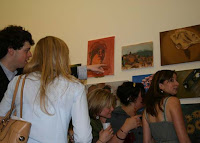 Last week Umbra students hopped here and there to sample the best Europe had to offer, and those of us who held down the fort here in good old Perugia were more than ready to hear their stories. Here’s an example of what took place during spring break study-abroad-style.
Last week Umbra students hopped here and there to sample the best Europe had to offer, and those of us who held down the fort here in good old Perugia were more than ready to hear their stories. Here’s an example of what took place during spring break study-abroad-style.
Kat Black and six of her fellow students left Perugia on a fine spring day bound for Switzerland, known of course for its remarkably clean and clear weather, towering Alps, and uncanny ability to manufacture some of Earth’s best chocolate.
The first day of the trip was spend exploring trails and paths surrounding quiet Interlaken, whichyielded magnificent panoramas and sweeping views of massive, true blue lakes and reaching white summits. On the second day it was all for the Alpine slopes, kicks being exchanged for ski boots, sweatshirts for heavy sweaters and thick jackets. Fresh powder had fallen the night before, making for a great and, well, powerdy time. Having spent the day shredding the powder, riding gondolas and becoming human ice-cubes, our adventurers had a warm, not too Italian dinner of juicy hamburgers (wait, aren’t those German?) followed by a hardy dose of sleep.
The next part of the trip took adventuring to a literally higher level, allpersons involved opting either to skydive or paraglide (none of which are for this author!) But then again, the best way to see Switzerland would have to be from the air… Or so we’re told…
Once safely on the gound again, the last bit of an awesome week was spent perusing a Swiss chocolate fair, which included nearly every sort of chocolate imaginable-no surprise there-and countless demonstrations of how to make, and naturally eat, chocolate. Sounds wonderful, right?
See all the pictures — and full-sized ones, at that — with the gallery below!
 exhibit a semester’s worth of paintings, drawings, and photographs to their fellow students, as well as professors and interested guests. The Via Danzetta art studio was crowded with Umbra students, professors, and interested guests hoping to review the artwork on display.
exhibit a semester’s worth of paintings, drawings, and photographs to their fellow students, as well as professors and interested guests. The Via Danzetta art studio was crowded with Umbra students, professors, and interested guests hoping to review the artwork on display.






 For most Americans the Easter holidays are over after Easter dinner, but for Italians, there’s one more day: Pasquetta. This name literally means “Little Easter” in Italian, and while they were with family on Sunday, Easter Monday is when young Italians go out with their friends. Despite yesterday’s inclement weather (Italy’s March is like the northeastern US April), the restaurants were full of friends laughing and eating. While some Umbra students were away taking advantage of the long weekend, others were celebrating Pasquetta all’italiana with their Italian friends. Another group took advantage of a local chocolate maker, Augusta Perusia, and had a hanndmade chocolate egg, along with traditional Easter cake. Yum! Buona Pasquetta!!!!
For most Americans the Easter holidays are over after Easter dinner, but for Italians, there’s one more day: Pasquetta. This name literally means “Little Easter” in Italian, and while they were with family on Sunday, Easter Monday is when young Italians go out with their friends. Despite yesterday’s inclement weather (Italy’s March is like the northeastern US April), the restaurants were full of friends laughing and eating. While some Umbra students were away taking advantage of the long weekend, others were celebrating Pasquetta all’italiana with their Italian friends. Another group took advantage of a local chocolate maker, Augusta Perusia, and had a hanndmade chocolate egg, along with traditional Easter cake. Yum! Buona Pasquetta!!!!
